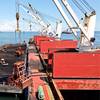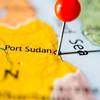USNS Bridge Joins MSC Fleet
The transfer of Bridge and her sister ships, USNS Rainier, USNS Arctic and USNS Supply, are part of the Navy’s continuing transformation to a more efficient and cost effective fighting force for the 21st century. According to a May 1998 Center for Naval Analysis study, the Navy will save a projected $76 million annually with the change.
The transfers also free up more than 100 active duty Navy officers and nearly 2,000 enlisted Sailors to return to the war-fighting roles for which they were trained.
The Navy also realizes additional savings because MSC ships are not constrained by the operational and personnel limitations placed upon Sailor-crewed ships. USNS ships have an 80 percent availability for at-sea service compared to 24 percent for Sailor-crewed ships. This increased availability means fewer ships are required to support logistics missions. With a top speed in excess of 25 knots, the 754-foot fast combat support ships are ideally suited to travel with U.S. Navy battle groups to provide underway replenishment of fuel, ammunition, spare parts and stores at sea, eliminating the need for the combatants to constantly return to port.
The transfer ceremony began with the arrival of the official party. Capt. Richard Stockton, USN, commanding officer of USS Bridge, led the group, followed by Capt. Jeffrey Siepert, who will command the ship under MSC; Capt. Juan L. Chavez, USN, commander of Military Sealift Command Pacific; Rear Adm. Leendert Hering, USN, Commander of Naval Surface Group Pacific Northwest; and Rear Adm. Deborah Loewer, USN, Vice Commander of MSC and guest speaker for the event.
As is tradition, the Bridge’s commissioning pennant was lowered during the ceremony and given to the departing commanding officer, Capt. Stockton. The ship’s ownership certificate was then passed to Capt. Chavez, effectively transferring ownership to MSC. Capt. Chavez then directed Capt. Siepert, the ship’s new civilian master, to “place the ship in service.” With those words, USS Bridge became USNS Bridge.
Just before the ceremony, the ship’s new master recounted working with USS Bridge in the Persian Gulf during Operation Iraqi Freedom.
“I was master of USNS Niagara Falls, one of MSC’s [combat] stores ships. I’d see the Bridge cutting through the sea at 30 knots while we were poking along at 18. I was jealous. I dreamed of commanding that ship. Now, I do. So tell your kids, dreams can come true!” exclaimed Siepert.
Capt. Stockton, who retired during the ceremony with more than 24 years service in the Navy, reflected on his former command.
“People ask me if this is a sad day. I don’t call it sadness. The ship isn’t going away; she’s charting new waters. “I was also thinking the other day ... the average age of the civilian mariners now manning the ship is about 48. The average age of my active-duty Navy crew was 22. Add up the sea time of the 160 mariners and you’ve got more experience than all my 500 Sailors totaled. The fleet will never know the difference when they pull alongside USNS Bridge ... and all of us can be proud of that.”
MSC’s logistics force includes fleet oilers, ammunition ships, combat stores ships, fleet ocean tugs and hospital ships. In addition to providing underway replenishment to U.S. Navy ships at sea, MSC ships are involved in the prepositioning and transportation of cargo for the Department of Defense and collect at-sea data for the U.S. military and other U.S. government agencies.
Since September 11, 2001, MSC has delivered more than 4.9 billion gallons of fuel and countless tons of food and ammunition to Navy ships around the globe in support of Operations Iraqi Freedom and Enduring Freedom. As of June 22, 2004, MSC has moved more than 55 million square feet of cargo in support of the global war on terrorism.
MSC normally operates 120 civilian-crewed, noncombatant ships for a variety of missions around the world. That number expanded to more than 210 in March 2003 as additional ships were activated from reduced operating status or chartered for the command's support of U.S. forces in Operation Iraqi Freedom.











